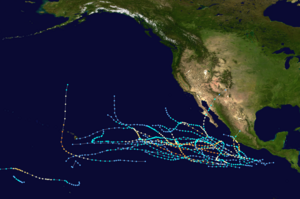| 1992 Pacific hurricane season | |
|---|---|
 Season summary map | |
| Seasonal boundaries | |
| First system formed | January 28, 1992 |
| Last system dissipated | November 23, 1992 |
| Strongest storm | |
| Name | Tina |
| • Maximum winds | 150 mph (240 km/h) (1-minute sustained) |
| • Lowest pressure | 932 mbar (hPa; 27.52 inHg) |
| Seasonal statistics | |
| Total depressions | 30 |
| Total storms | 27 (record high) |
| Hurricanes | 16 (record high, tied with 1990, 2014, and 2015) |
| Major hurricanes (Cat. 3+) | 10 (Second-most, tied with 2018) |
| Total fatalities | 25 total |
| Total damage | ≥ $3.15 billion (1992 USD) |
| Related articles | |
The 1992 Pacific hurricane season is the most active Pacific hurricane season on record, featuring 27 named storms. The season also produced the second-highest ACE value on record in the basin, only surpassed by the 2018 season. The 1992 season officially started on May 15 in the eastern Pacific, and on June 1 in the central Pacific, and lasted until November 30. These dates conventionally delimit the period of each year when most tropical cyclones form in the northeastern Pacific Ocean.[1] However, tropical cyclogenesis is possible at any time of the year, as demonstrated by the development of Hurricane Ekeka on January 28, and Tropical Storm Hali two months later.
The most notable storm was Hurricane Iniki, which caused billions of dollars of damage to the Hawaiian Islands, primarily in Kauai, along with six fatalities. Hurricanes Lester, Virgil, Winifred, and Orlene also made landfall and killed several people, but were significantly less destructive. Hurricane Darby and Tropical Storm Agatha brought rains and more destruction to Mexico, without making landfall. Hurricane Tina was, in addition to being the strongest storm of the year, the longest-lasting Pacific hurricane at the time.
- ^ Dorst Neal. "When is hurricane season?". Atlantic Oceanographic and Meteorological Laboratory. Archived from the original on December 6, 2010. Retrieved November 25, 2010.